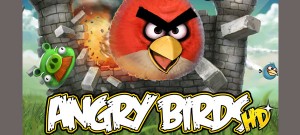I tried to figure out why I’m hooked on such a silly game. Have you ever played Angry Birds? It’s addicting. I keep going back when I have so many other things to do that are more productive. What is it about Angry Birds that hooks me and so many people? Cinematic Trailer of Angry Birds
I am having trouble getting past level 7 but my 3 year old granddaughter can. Very frustrating! So I keep playing. Not during the day though. I do this at night to calm me down to sleep. You probably wonder how Angry Birds can calm me down. So I read this article “Why Angry Birds is so successful and popular: a cognitive tear down of the user experience” by Charles Mauro.
I looked at his question “why is an interface so engaging that users cannot stop interacting with it?” to see how we could use this information for instructional design. The first thing I think about is accessibility. You can access Angry Birds from every mobile device. If you have never played the game, here is a synopsis from the article:
The game involves employing a sling shot to propel small cannonball-shaped birds with really bad attitudes at rather fragile glass and timber houses populated by basically catatonic green pigs. The basic thrust of the game is to bring about the demise of the pigs as quickly and expertly as possible by collapsing the pigs’ houses on top of their (sometimes) helmeted heads.
The thing that gets to me is that over 50 million people have downloaded this game. More each day. That’s over 200 million minutes a day on a game where you sling birds to kill annoying pigs. Now really? With user design, usually faster is better. But not in this case. Sometimes you sling a bird the hovers over the pigs house and dangles back and forth. Maybe it works. Sometimes it doesn’t kill the pig. Or if it does kill the pig, it takes a long time for the pig to die. It’s not how fast your sling the bird but how you sling it. The user has options with the birds that you figure out after you start. If you click on some of the birds in flight, they go faster or divide into more birds. It’s like a secret. Kind of like In n Our Burger where I order a special style of my burger. It’s not on the menu but those in the know know it.
So fast is okay but being smarter and in the know is much better.
One thing the designers of Angry Birds did that grabs you is the interface design. When you first arrive at the level, you see the house with the pigs so you can get an idea of where you are going to throw the birds. Then it scrolls to the left to see the birds putting the pigs out of sight. Very clever of the designers! Frustrating for the users to the point that it becomes a game in itself to scroll back and forth to see where you are going to what angle and force to sling the birds. This impacts the user to want to try again and again. How many of you got stuck on a level and then decided to pinch down the screen so you can see everything?
That changes everything. Now you can figure out how to kill the pigs easy. If it was easy, Angry Birds wouldn’t be as popular and as addictive. The idea of moving the pigs off the screen makes it just enough of a challenge to keep trying to get to the next level.
Some ideas to thing about:
- What if we designed learning activities that were challenging enough that pushed us out of our comfort zone?
- Ask students to design a game with some of the design strategies like Angry Birds that teaches a math concept.
- Map your curriculum with your colleagues to determine where there are gaps in learning. Then collaborate on one project that challenges and engages students.
- Create activities that students can access on their mobile device.
- Allow mobile devices in the classroom.
Think about how you can change how you teach and how your students learn. Just imagine your students saying “I’m busy right now… learning.”





[…] the task gradually. Learning from Angry Birds: Barbara Bray Getting Your Game On: Andrew Miller (Curriculum Units) These three articles are well […]